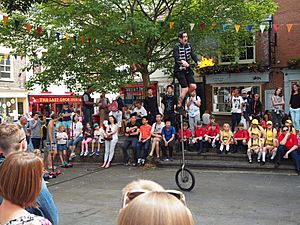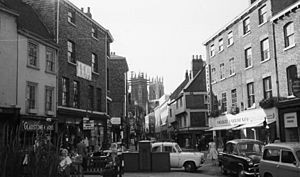King's Square (York) facts for kids
King's Square is a lively open space right in the middle of York, a historic city in England. It's a popular spot where people gather and enjoy the city atmosphere.
Contents
A Look Back: The History of King's Square
Ancient Beginnings: Roman Times
Long, long ago, when the Romans ruled, the area where King's Square now stands was very important. Around the year 108 AD, the main south-eastern gate of the Roman city of Eboracum was built here. You can even see a stone with an inscription about it at the Yorkshire Museum today!
Royal Connections: The Viking Age
Later, in the 10th century, a famous Viking named Egil Skallagrimsson wrote about this place. He called it "Konungsgarthr," which means "King's Garden" or "King's Court." This makes many people think that a royal palace might have stood here. It could have been the home of kings from the Danelaw (a Viking-ruled part of England), or even earlier kingdoms like Northumbria and Deira.
Growing Over Time: From Shops to a Square
By the 1400s, the west side of the square was lined with shops. These shops belonged to "mercers," who were people who sold fine fabrics like silk and velvet. There was also a building called "Hellekeld" nearby. In 1627, a building called Duke Gill Hall was on the north-east side. People said it used to be known as "the King's Court."
For a long time, King's Square was quite small. It was often seen as just the southern part of Low Petergate. It was also very close to the churchyard of Holy Trinity, King's Court.
Becoming the Square We Know Today
Over the years, the churchyard became smaller. By 1780, the area officially became known as "King's Square." In 1937, the old church itself was taken down. This allowed the square to become the size it is today. Some of the old gravestones from the churchyard were even used to pave parts of the square!
Some very old buildings from the Mediaeval period (the Middle Ages) on King's Court were still standing until the 1950s. The square also grew to include parts of Colliergate and the whole street of King's Court. Even though the square is bigger now, some buildings still keep those old street names.
In 2013, the City of York Council spent a lot of money, about £490,000, to make the square even better. Today, King's Square is a popular place for visitors. You can often see talented buskers (street musicians) and other performers entertaining the crowds. A famous expert named Nikolaus Pevsner once said that the trees in the square make it special. You can also find the York's Chocolate Story attraction on the west side of the square, which is a fun place to learn about chocolate!
Exploring the Layout and Buildings
Shape and Surrounding Streets
King's Square has an interesting triangular shape. From its northern tip, three streets lead away: Low Petergate goes north-west, Church Street goes south-west, and Goodramgate goes north-east.
From the south-western point of the square, Newgate heads west, and The Shambles goes south. From the south-eastern point, Colliergate leads south. You can also find St Andrewgate running north-east from the middle of the square's north-east side.
Notable Buildings Around the Square
On the south-west side, you'll find number 5 King's Square, which was built way back in 1587. Nearby, 4 King's Court is a very old building from the 15th century, though it was rebuilt in 1963. Pump Court also has Mediaeval roots, but it has been rebuilt several times, in 1755 and again in 1951. Between these is Refuge House, built in 1963.
On the south-east side, there's St Trinity House. This building was originally three separate houses, hidden behind the old church, and they date back to the 15th century or even earlier! On the north-east side, 2 King's Court is a shop that was built in the early 1800s.



